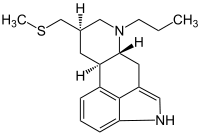Pergolide
Pergolide (trade names Permax, Prascend) is an ergoline-based dopamine receptor agonist used in some countries for the treatment of Parkinson's disease (PD). PD is associated with reduced dopamine activity in the substantia nigra of the brain. Pergolide acts on many of the same receptors as dopamine to increase receptor activity.
 | |
| Clinical data | |
|---|---|
| Other names | (6aR,9R,10aR)-9-(methylthiomethyl)-7-propyl-4,6,6a,7,8,9,10,10a-octahydroindolo[4,3-fg]quinoline |
| AHFS/Drugs.com | Monograph |
| Pregnancy category |
|
| Routes of administration | Oral |
| ATC code | |
| Legal status | |
| Legal status |
|
| Pharmacokinetic data | |
| Protein binding | 90% |
| Metabolism | Extensively hepatic |
| Elimination half-life | 27 hours |
| Identifiers | |
IUPAC name
| |
| CAS Number | |
| PubChem CID | |
| IUPHAR/BPS | |
| DrugBank | |
| ChemSpider | |
| UNII | |
| KEGG | |
| ChEBI | |
| ChEMBL | |
| CompTox Dashboard (EPA) | |
| ECHA InfoCard | 100.241.322 |
| Chemical and physical data | |
| Formula | C19H26N2S |
| Molar mass | 314.489 g/mol g·mol−1 |
| 3D model (JSmol) | |
SMILES
| |
InChI
| |
| | |
It was patented in 1978 and approved for medical use in 1989.[1] In 2007, pergolide was withdrawn from the U.S. market for human use after several published studies revealed a link between the drug and increased rates of valvular heart disease.[2] However, a veterinary form of pergolide, marketed under the trade name Prascend, is permitted for the treatment of pituitary pars intermedia dysfunction (PPID) also known as equine Cushing's syndrome (ECS) in horses.[3]
Indications
Pergolide is not available for use by humans in the United States, however, it is still used in various other countries, where it is used to treat various conditions including Parkinson's disease, hyperprolactinemia, and restless leg syndrome.
Pergolide is available for veterinary use. Under the trade name Prascend, manufactured by Boehringer Ingelheim,[4] it is commonly used for the treatment of pituitary pars intermedia hyperplasia or Equine Cushing's Syndrome (ECS) in horses.[5]
Pharmacology
Pergolide acts as an agonist of dopamine D2 and D1 and serotonin 5-HT1A, 5-HT1B, 5-HT2A, 5-HT2B, and 5-HT2C receptors. It may possess agonist activity at other dopamine receptor subtypes as well, similar to cabergoline. Although pergolide is more potent as an agonist of the D2 receptor, it has high D1 receptor affinity and is one of the most potent D1 receptor agonists of the dopamine receptor agonists that are clinically available.[6] The agonist activity of pergolide at the D1 receptor somewhat alters its clinical and side effect profile in the treatment of Parkinson's disease.
Side effects
The drug is in decreasing use, as it was reported in 2003 to be associated with a form of heart disease called cardiac fibrosis.[7] In 2007, The United States Food and Drug Administration announced a voluntary withdrawal of the drug by manufacturers due to the possibility of heart valve damage.[8] Pergolide is not currently available in the United States for human use. This problem is thought to be due to pergolide's action at the 5-HT2B serotonin receptors of cardiac myocytes, causing proliferative valve disease by the same mechanism as ergotamine, methysergide, fenfluramine, and other serotonin 5-HT2B agonists, including serotonin itself when elevated in the blood in carcinoid syndrome. Pergolide can rarely cause Raynaud's phenomenon. Among similar antiparkinsonian drugs, cabergoline but not lisuride exhibit this same type of serotonin receptor binding.[9] In January, 2007, cabergoline (Dostinex) was reported also to be associated with valvular proliferation heart damage.[10] In March 2007, pergolide was withdrawn from the U.S. market for human use, due to serious valvular damage that was shown in two independent studies.[11]
Pergolide has also been shown to impair associative learning.[12]
Claimed side effects
At least one British pergolide user has attracted some media attention with claims that it has caused him to develop a gambling addiction.[13][14] In June 2010, it was reported that more than 100 Australian users of the drug are suing the manufacturer over both gambling and sex addiction[15] problems they claim are the result of the drug's side effects.
References
- Fischer, Jnos; Ganellin, C. Robin (2006). Analogue-based Drug Discovery. John Wiley & Sons. p. 533. ISBN 9783527607495.
- FDA Public Health Advisory: Pergolide (marketed as Permax)
- http://www.valleyvet.com/ct_detail.html?pgguid=e0f4888c-86de-4ce9-9013-6d947df697a8&gas=pergolide%20mesylate
- Barbara Forney, VMD. "Pergolide For Veterinary Use".
- McClure, Margaret M; Harvey, Philip D; Goodman, Marianne; Triebwasser, Joseph; New, Antonia; Koenigsberg, Harold W; Sprung, Larry J; Flory, Janine D; Siever, Larry J (2010). "Pergolide Treatment of Cognitive Deficits Associated with Schizotypal Personality Disorder: Continued Evidence of the Importance of the Dopamine System in the Schizophrenia Spectrum". Neuropsychopharmacology. 35 (6): 1356–1362. doi:10.1038/npp.2010.5. ISSN 0893-133X. PMC 3055340. PMID 20130535.
- ADRAC (August 2004). "Cardiac valvulopathy with pergolide". Aust Adv Drug React Bull. 23 (4). Archived from the original on 2007-12-15.
- Public Health Advisory - Pergolide (marketed as Permax)
- Jähnichen S, Horowski R, Pertz H. ""Pergolide and Cabergoline But not Lisuride Exhibit Agonist Efficacy at Serotonin 5-HT2B Receptors"" (PDF). (515 KiB) Presentation. Retrieved on 2007-03-30.
- Schade R, Andersohn F, Suissa S, Haverkamp W, Garbe E (2007). "Dopamine agonists and the risk of cardiac-valve regurgitation". N Engl J Med. 356 (1): 29–38. doi:10.1056/NEJMoa062222. PMID 17202453.
- "MedWatch - 2007 Safety Information Alerts. Permax (pergolide) and generic equivalents". U.S. Food and Drug Administration. March 29, 2007. Retrieved 2007-03-30.
- Breitenstein C, et al. (2006). "Tonic dopaminergic stimulation impairs associative learning in healthy subjects". Neuropsychopharmacology. 31 (11): 2552–64. doi:10.1038/sj.npp.1301167. PMID 16880771.
- "Drug 'caused' gambling addiction" BBC TV 24 Jan. 2008
- "Parkinson's Gambler" ITV.com 5 Feb. 2008
- "Parkinson's treatment linked to sex, gambling" 'The Age' 4 June 2010